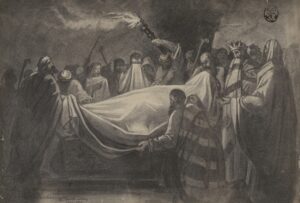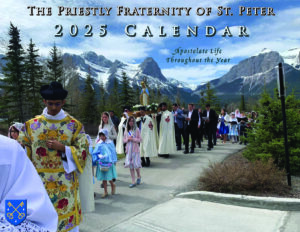Requiem Masses after the Day of Burial
by Fr. William Rock, FSSP

From the very foundation of Christianity, Masses and prayers have been offered up for the repose of the souls of the departed.1 In the Roman tradition, this practice developed into the various Requiem Masses, prayers, and other suffrages for the dead. Named after the first word of the Introit (entrance chant), a Requiem Mass is a Mass whose focus is the repose of the soul (or souls) of the departed. The Requiem Mass is, therefore, a Mass for the dead. All of the Requiem Masses share the same chants (Introit, Gradual, Tract, Sequence, Offertory, and Communion), but the orations (Collect, Secret, and Postcommunion) and readings (Epistle and Gospel) vary. There are Requiem Masses for the Day of Death or Burial, three for All Souls Day, on the Anniversary Day of the Death or Burial, the daily Mass for the Dead, and those for the Third, Seventh, and Thirtieth Day after the Burial.
The Requiem Masses which can be offered on the third, seventh, and thirtieth days after the burial are the same as the Mass of the Day of Burial (Epistle: 1 Thess. 4:13-18; Gospel: John 11:21-27) with the following orations:2
(Collect) We beseech Thee, O Lord, that Thou wouldst vouchsafe to grant fellowship with Thy saints and elect to the soul of the Thy servant (or handmaid) N., the third (or seventh or thirtieth) day of whose burial we commemorate, and wouldst pour out the everlasting dew of Thy mercy. Through Our Lord…
(Secret) Look favorably, we beseech Thee, O Lord, upon the offerings we make on behalf of the soul of Thy servant (or handmaid) N., that cleansed by heavenly remedies, it may rest in Thy mercy. Through Our Lord…
(Postcommunion) Receive our prayers, O Lord, on behalf of the soul of Thy servant (or handmaid) N., that if any stains of earthly contagion remain, they may be washed away by Thy merciful forgiveness. Through Our Lord…

Offering Masses on these days for the departed is very ancient and symbolic reasons have been given for their celebration.3 “With regard to the third day, as commemorative of the three days which Christ passed in the sepulcher, and as presaging the Resurrection, there is special prescription in the Apostolic Constitutions [4th Century] (VIII, xlii): ‘With respect to the dead, let the third day be celebrated in psalms, lessons, and prayers, because of Him who on the third day rose again.’”4 Evidence of the Masses offered on the seventh and thirtieth day is found in the works of St. Ambrose (d. A.D. 397): “Now, since on the seventh day, which is symbolical of eternal repose, we return to the sepulchre”5 (De fide. resurr.), and
Because some people are accustomed to observe the third and thirtieth day and some the seventh and the fortieth, let us look closely at what the text of Scripture teaches. When Jacob died, it says, Joseph instructed the undertakers in his service to bury him. And they buried Israel. And forty days were completed for him; for this is how the days of the funeral rites are reckoned. And Egypt mourned him for seventy days [Gen 50:2-3 according to the Itala]. This, then, is the observance to be followed, which is set out in the text. But equally, in Deuteronomy it is written that the children of Israel mourned Moses for thirty days and the days of mourning were completed [Deut. 34:8 according to the Itala]. So either observance has the authority through which the duty required of filial piety is fulfilled. (De ob. Theodosii, iii)6
In the Roman tradition, then, the Mass on the third day can be seen as being done in honor of the days Our Lord’s Body rested in the tomb and also His Resurrection, on the seventh as expressing eternal repose, and on the thirtieth in imitation of mourning of Moses by the Hebrews.
In the 1962 edition of the Roman Missal, these three Masses are votive of the third class, so they can be celebrated on fourth or third class days according to the rubrics (rubric 415). The computation of these days, however, is a bit complicated. In this regard, the 1959 edition of Matters Liturgical gives the following:
In computing the day of the Mass, one must count three or seven or thirty days exactly. This count, however, may be made either from day of death or from the day of burial; in either case the day of death or the day of burial may be either included or excluded. Consistency is not required in computing all these privileged days for the same person; thus the 3rd day may be computed from the day of burial exclusively, the 7th day from the day of burial inclusively, and the 30th day from the day of death either inclusively or exclusively. One may have these privileged Masses said on all three days or on one or two of them only; all three Masses may be said for one and the same person, not only in one church or oratory, but in more than one. It should, however, be noted that only the first 30th day is privileged. (294.d)

It is fitting that during this month dedicated the Holy Souls that the Faithful be urged, when preparing the funeral rites of a loved one, or even for oneself (if plans are being made in advance), to see if this ancient tradition of celebrating Masses for the departed on the third, seventh, and thirtieth days can be arranged as well, so that this venerable tradition may continue, and the souls for whom these Masses are offered receive the associated spiritual assistance.
Fr. Wiliam Rock, FSSP was ordained in the fall of 2019 and is currently assigned to Regina Caeli Parish in Houston, TX.
- See, for example, Appendix II of Neale, J. M.’s The Liturgies of the Saints (Piscataway: Gorgias Press, 2002) and the Old Catholic Encyclopedia, s.v. “Prayers for the Dead.”
- The translations of these orations are based on those presented in The Saint Andrew Daily Missal (St. Paul: The E. M. Lohmann Co., 1940), p. [99] and The Roman Catholic Daily Missal (Kansas City: Angelus Press, 2004), pp. 1617-1618.
- Old Catholic Encyclopedia, s.v. “Masses of Requiem.”
- Ibid.
- Ibid.
- Translated Texts for Historians, Volume 43 – Ambrose of Milan: Political Letters and Speeches. Trans. Liebeschuetz, J. H. W. G. with the assistance of Hill, Carole. (Liverpool: Liverpool University Press, 2005), p. 178.
November 2, 2023









